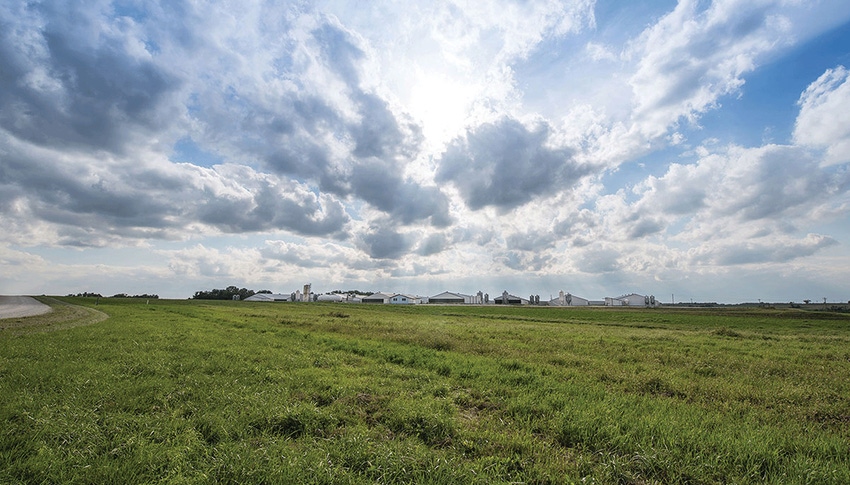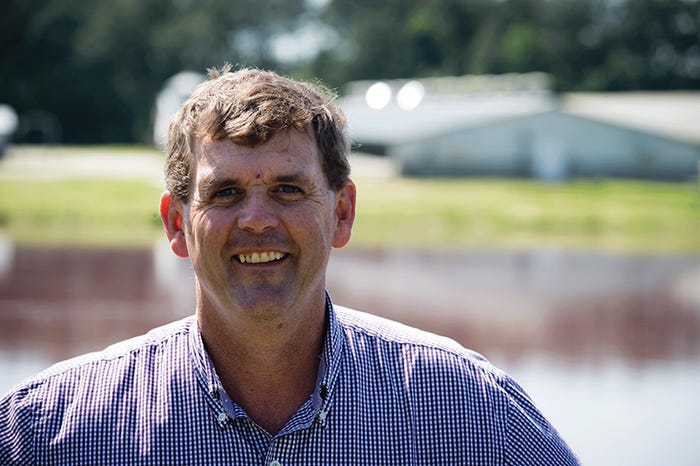People care more and more about where their food comes from, but they also want to know the impact its production has on the planet.

Sustainability is a buzzword with multiple meanings — social, economic or environmental. While the terminology seems fairly new, the actual concept has not only sustained over time, but also blossomed into a social movement that people place high value on today.
People care more and more about where their food comes from, but they also want to know the impact its production has on the planet. America’s pig farmers share this value with their customers by striving to produce safe food without compromising the welfare of the animal, depleting natural resources or sacrificing human health.
Today’s hog farmers have made strides over the last few decades in reducing their environmental footprint and enhancing animal welfare. A recent study of the entire pork chain conducted by the University of Arkansas shows U.S. pig farmers have reduced land use by 78%, water use by 41% and their carbon footprint by 35% over the past 50 years. Still, the industry knows there is always room to do better and desires to continuously improve.
Like its fellow pig farmers, Smithfield Foods — the global food company that is also the world’s largest hog producer and pork processor — has worked over the years to lessen its demand for natural resources. In 2016, the company took its goals a step further.
Kraig Westerbeek, senior director of Smithfield Renewables, tells National Hog Farmer the company wanted to take its environmental stewardship efforts to the next level by setting a lofty goal to shrink its carbon footprint.
“In December 2016, Smithfield announced its goal to reduce greenhouse gas emissions 25% by 2025. It is based on a 2010 baseline,” he says.

Kraig Westerbeek is senior director of Smithfield Renewables.
Stepping up efforts
For animal ag, this is a first-of-its-kind environmental initiative focusing on the entire supply chain, from feed to packaged bacon. Smithfield is also the first protein company to announce a goal to significantly reduce absolute GHG emissions, with a target equivalent of removing 900,000 cars from the road.
Recent consumer research shows consumers are factoring a company’s sustainability into their food-buying decisions. Smithfield shares consumers’ concern for the environment, but that is not the only reason for its bold goals. The company says it simply wants to do what is right for people, the planet and pigs.
Over the years, Smithfield has been involved in renewable energy and biogas projects, and more recently unified these programs into a more comprehensive, coordinated effort. In 2017, the company officially formed Smithfield Renewables with a focus to meet its carbon reduction goal and accelerate renewable energy initiatives, trying to capture value across the supply chain.
“Smithfield has always been a leader in sustainability,” Westerbeek says. “We have challenged ourselves over the years in a lot of different areas, whether that was reduction in energy, electricity or water usage. Doing more with less is something our business strives to do. Our ambitious goals will yield both environmental and economic benefits.”
Until now, Smithfield looked at sustainability only within its own walls and not the entire supply chain. So stepping back, the company began quantifying its whole environmental footprint, which encompasses its complete supply chain — including grain production and processing.
Working with a model from the University of Minnesota, Smithfield was able to identify its carbon footprint. Westerbeek says this gave them a clear look at the areas dominating Smithfield’s GHG emissions. Very similar to the rest of animal agriculture production, the company’s emissions fall into four buckets:
1. Manure management. Methane gas, as a product of manure breaking down, does contribute largely to a hog farm’s overall carbon footprint. As much as 41% of Smithfield’s footprint stems from methane emissions resulting from hog manure on company and contract farms.
2. Grain supply chain. From the fertilizer used to grow the crop to transportation, feed ingredients together make up a large portion of the carbon footprint.
3. Electricity use. This includes in feed mills and processing plants.
4. Overall efficiency. Similar to fellow hog farmers, Smithfield over the years has made progress in feed conversion by producing more pounds of pork with less feed. Improving feed efficiencies helps shrink not only the carbon footprint, but also water, land and air footprints.
“If you look overall at our carbon reduction initiative, the improvement in production efficiencies over time actually overlays all that,” Westerbeek says. “Obviously, if we can produce the same amount of pork with less corn, then our footprint on the grain side is less. If we can produce the same amount of pork with less manure, then you lower the footprint there.
“Those are four key areas we look at. It is not just the growing of animals or finishing side. We also look at improving efficiency. If one sow produces 10% to 12% more pigs than 10 years ago, then that improves our overall productivity.”
Westerbeek points out it is not just the animal production division contributing to Smithfield’s overall carbon footprint. On the retail side, consumer preparation is also a significant contributor. “It is almost as big as our manure management and grain supply,” he notes.

Every hog farmer struggles with handling manure responsibly. Smithfield Foods sees manure management as an opportunity to be the ultimate nutrient recycler.
Nutrient recyclers
Every hog farmer is challenged with handling manure responsibly. As the world’s largest pork producer, managing manure is a hefty task. In general, manure is valuable natural organic matter. To get full value from its manure, Smithfield looks toward innovation and partnerships to be the ultimate recycler, converting hog manure to fertilizer for crops or to different types of energy.
Recently, Smithfield partnered with Anuvia Plant Nutrients to create sustainable fertilizer from renewable biological materials collected from manure treatment systems at Smithfield’s hog farms. The project reuses organic matter found in hog manure to create a commercial-grade fertilizer that is higher in nutrient concentration than the original organic materials.
Anuvia, which specializes in the transformation of organic materials into enhanced-efficiency fertilizer products, will manufacture and sell these commercial-grade fertilizer products to farmers nationwide. They will use remnant solids from Smithfield that accumulate over time at the bottom of the anaerobic lagoons, basins designed and certified to treat and store the manure on company-owned and contract hog farms in North Carolina.
Smithfield will begin the process by collecting and de-watering the waste solids before providing the remnants to Anuvia. Once acquired, Anuvia will pick up and transport the material to its processing plant to create the fertilizer.
“This relationship provides a new sustainable way for Smithfield to return its remnant solids back to the land for use on the crops grown to feed the hogs. The impact of this is extremely significant for hog production and the livestock industry,” says Amy Yoder, Anuvia Plant Nutrients chief executive officer.
Two of the largest swine manure-to-energy facilities are on Smithfield’s farms in Utah and Missouri.
More than 400,000 hogs are finished on the Utah farm, and the manure from that farm goes to a central methane digester to produce biogas which powers generators that produce electricity for the grid near Milford, Utah.
In northern Missouri, Smithfield teamed up with Roeslein Alternative Energy of St. Louis for one of the largest anaerobic digestion programs in the United States. Roeslein takes the biogas from lagoons of nine hog finishing farms, cleans it and injects it into natural gas pipelines. It is expected to produce enough renewable natural gas to supply electricity to about 15,400 homes for a year.
The newest endeavor is in Duplin County, N.C., where anaerobic waste digesters are now capturing biogas from some 60,000 hogs on five Smithfield contract farms. Smithfield leases land to Optima KV that has a natural gas transmission line running to collect and clean gas.
Optima built new waste collection systems at each of the barns at the participating farms to reroute hog manure and liquids away from the properties’ lagoons and into digesters. After the manure is digested, biogas that is captured from the digesters is upgraded to pipeline-ready natural gas, and the treated effluent from the digesters flows back into the existing lagoons. Farmers then use that nutrient-rich mixture to irrigate and fertilize their crops.
The digesters offer an environment free of oxygen, which enables anaerobic bacteria to grow while feeding on the hog waste. In turn, the bacteria emit methane, or natural gas, as well as carbon dioxide. Once upgraded from the biogas, the natural gas is injected into the nearby pipelines. Duke Energy has signed a 15-year agreement to purchase the renewable natural gas, expected to power roughly 950 households in North Carolina.
Door of opportunities
When you’re the largest pork producer, everyone comes knocking with ideas. As a company, Smithfield sees that as an opportunity. Searching for global solutions as innovation and new technology become available is a continuing mission for Smithfield Renewables.
“If you look at it from a technology standpoint, we probably talk to everyone, and we can take a look at various proposals available. We have participated in a lot of activities like the Environmental Protection Agency’s Nutrient Recycling Challenge to try to bring good ideas to industry that could also, one day, add value to our company,” Westerbeek says. “When you are the largest, everyone wants to talk to you and come to you with ideas. While that takes a lot of time, I think it also puts you in position to find opportunities to make partnerships.”
In 2013, Smithfield made a commitment to Walmart that 75% of its grain-sourcing acres would be engaged in fertilizer optimization or soil health best management practices by this year. This was a challenge since Smithfield purchases grain from farmers, and the company is not directly involved in the grain production itself.
As a result, the company collaborated with the Environmental Defense Fund to help farmers find ways to optimize fertilizer use and minimize related runoff on their farms.
The Smithfield Agronomics program, also known as SmithfieldGro, was launched as free agronomy advice and tools to enable farmers to incorporate more efficient practices that produce the same amount of grain using less fertilizer. Several on-staff agronomists travel throughout the Southeast and Midwest, demonstrating strategies to improve fertilizer usage and boost soil health.
Last year, Smithfield added a new technology to the SmithfieldGro arsenal: Adapt-N, a nitrogen management solution to help farmers improve their economic and environmental performance on 100,000 acres of fields that produce corn for swine feed.
“We are not shy about talking to grain producers about cover crops, fertilizer optimization or variable-rate application,” Westerbeek says. “We found farmers are very receptive because we are not trying to sell them anything. We want to buy their grain, but they can sell it to anyone they want.”
Tracking progress
Consequently, in 2017 69% of total grain purchases by Smithfield came from 410,830 acres of farmland participating in the SmithfieldGro program. Smithfield is on track to meet its 2018 goal to secure 75% of grain from farmers who grow this crop with efficient fertilizer and soil health practices.
One reason U.S. pig farmers’ progress in shrinking their environmental footprint seems to be the untold story is that producers are working on improving efficiency, but are not talking about it or measuring the improvement.
Smithfield is committed to reporting its progress by continuing to work with the University of Minnesota’s NorthStar Initiative for Sustainable Enterprise to trace its agricultural supply chain, and releasing the information in its annual sustainability reports.
“We are going to make sure we have outside verification of anything we make public with regards to how we are doing versus our goal,” Westerbeek says.
Since 2014, the company has reduced GHG emissions by 7.4%, water use by 2.5% and solid waste by 7.4%. Smithfield does report energy use up 1.9% due to the increase in ready-to-eat foods, which require greater energy use at the company’s production plants but use less energy for food-service customers and consumers to prepare.
The company is also willing to share knowledge with other pork producers. Westerbeek talks to hog farmers regularly about making improvements on the farm.
“I tell them that what we try to focus on is finding solutions that make sense on every level — environmental, economic, for the community and consumer. Finding those win-win-wins out there is what we are trying to do,” he explains. “As a company, we challenge ourselves to improve constantly.”
Many of the solutions tested and implemented at Smithfield are doable on any size hog operation. As Westerbeek reminds us, the majority of hogs harvested by Smithfield are not raised on company-owned farms. So, finding solutions that work for any hog operation is beneficial for all.
Still, Westerbeek advises that some opportunities are regionally based. There is not necessarily a one-size-fits-all solution. However, technology focused on production efficiency can help all hog farmers.
“It is about taking a look at your operation and seeing what you can do to improve your footprint, whether it is carbon, air or water. Honestly, I think it is something pork producers do already,” he says.
As a National Pork Producers Council board member, Westerbeek engages with many producers, and he is impressed with the amount of information available through the industry associations.
“What I am constantly impressed by is this industry is always looking forward. They are always looking for better ways to do things,” he says. “At Smithfield, we are no different. We are larger, maybe, but we share that same passion for moving forward and continuously doing things better.”
While Smithfield currently has many projects — especially related to renewable energy — in the works, there is more to come.
“We have some very interesting and exciting biogas projects to announce over the next several months and in several states,” Westerbeek says, with excitement in his voice. “We really believe manure to renewable natural gas makes sense, and we are going to have some very exciting announcements in that area in the near future.”
About the Author(s)
You May Also Like



